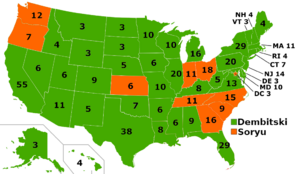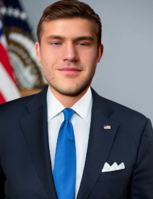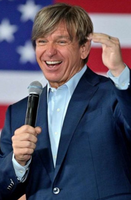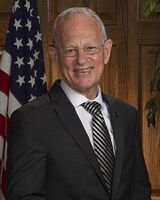2036 American Presidential Election
|
| |||||||||||||||||||||||||||||
| |||||||||||||||||||||||||||||
538 members of the Electoral College 270 votes needed to win | |||||||||||||||||||||||||||||
|---|---|---|---|---|---|---|---|---|---|---|---|---|---|---|---|---|---|---|---|---|---|---|---|---|---|---|---|---|---|
| Turnout | 78.2% | ||||||||||||||||||||||||||||
|
| |||||||||||||||||||||||||||||
 Presidential election results map. Green denotes states won by Dembitski/LaVenia and orange denotes those won by Soryu/Desantis. Numbers indicate electoral votes cast by each state and the District of Columbia. | |||||||||||||||||||||||||||||
| |||||||||||||||||||||||||||||
The 2036 United States presidential election was the 62nd quadrennial presidential election, held on Tuesday, November 6, 2036. The Democratic ticket of Antos Dembitski and the New York Senator Gloria Mattera defeated the Candidates Asuka Langley Soryu and Shinji Ikari. The election saw the decline in voter turnout, becoming 78%, with Dembitski's ticket receiving more than 315 million votes, surpassing his own record record of 143 million votes from 2032. Dembitski received more than 315 million votes, the most votes ever cast for a candidate in a U.S. presidential election till this day.
President Antos Dembitski, seeking reelection for a second term, ran as the incumbent from the Green-Democratic Party. His campaign focused on progressive and eco-socialist policies, with notable achievements in addressing climate change, income inequality, and healthcare reform during his first term.
Asuka Langley Soryu, representing the opposition party, was a decorated military veteran and former Senator known for her dedication to national security and veterans' issues. Her candidacy emphasized strong national defense, international diplomacy, and a pragmatic approach to governance.
The 2036 United States Presidential Election gained notoriety for its unique dynamic, where a satirical political party, "Asuka's Party of the United States," headed by Asuka Langley Soryu, emerged as the second-largest party, surpassing the long-established Republican Party in terms of popularity and electoral support. This unprecedented development marked a significant departure from traditional American politics.
Asuka's Party, known for its satirical and unconventional approach, attracted attention with its charismatic leader and unorthodox campaign style. While the party's platform was lighthearted and satirical in nature, it resonated with a segment of the electorate dissatisfied with the traditional political landscape. Its rise to prominence demonstrated the electorate's desire for fresh perspectives and a break from conventional politics.
Throughout the campaign, these critical issues took center stage, dominating the discourse as candidates and parties articulated their visions for the future. Climate change, in particular, loomed large as a defining issue, reflecting a growing recognition of the environmental challenges facing the planet and the need for comprehensive, forward-thinking policies to combat them. Economic matters also commanded considerable attention. Debates on income inequality, job creation, and economic growth were central to the campaigns, with candidates presenting contrasting approaches to address these complex issues. Healthcare remained a constant concern, with differing proposals for reform generating significant public debate. The role of the United States on the global stage was another major theme, with candidates outlining their visions for American foreign policy. Diplomacy, international cooperation, and the country's posture on international crises all weighed heavily in the minds of voters.
Background
Article Two (revised in the early 2030s) of the United States Constitution states that for a person to serve as president, the individual must be a natural-born citizen of the United States, be at least 24 years old, and have been a United States resident for at least 14 years. Candidates for the presidency typically seek the nomination of one of the various political parties in the United States. Each party develops a method (such as a primary election) to choose the candidate the party deems best suited to run for the position. Primary elections are usually indirect elections where voters cast ballots for a slate of party delegates pledged to a particular candidate.
The party's delegates then officially nominate a candidate to run on the party's behalf. The presidential nominee typically chooses a vice presidential running mate to form that party's ticket, which is then ratified by the delegates at the party's convention (except for the Libertarian Party, which nominates its vice-presidential candidate by delegate vote regardless of the presidential nominee's preference). The general election in November is also an indirect election, in which voters cast ballots for a slate of members of the Electoral College; these electors then directly elect the president and vice president. If no candidate receives the minimum 270 electoral votes needed to win the election, the United States House of Representatives will select the president from among the three candidates who received the most electoral votes, and the United States Senate will select the vice president from among the candidates who received the two highest totals. The presidential election occurred simultaneously alongside elections for the House of Representatives, the Senate, and various state and local-level elections.
On December 14, 2032, pledged electors for each candidate, known collectively as the United States Electoral College, gathered in their states' capitols to cast their official votes. Pursuant to the processes laid out by the Electoral Count Act of 1887, certificates of ascertainment listing the names of the electors and separate certificates recording their votes are distributed to various officials across the branches of government. The newly elected Congress, with the Vice President in his role as Senate President presiding, met in a joint session to formally open the certificates and count the votes, which began on December 15, 2036.
Nominations
Green-Democratic Party
Antos Dembitski became the presumptive nominee of the Green Party on June 1, 2036, when he secured enough delegates almost immediately to ensure his nomination at the national convention. He was formally nominated at the convention on September 1st.
| 2036 Green-Democratic Party Ticket | |||||||||||||||||||||||||||||
| Antos Dembitski | Gloria Mattera | ||||||||||||||||||||||||||||
|---|---|---|---|---|---|---|---|---|---|---|---|---|---|---|---|---|---|---|---|---|---|---|---|---|---|---|---|---|---|
| for President | for Vice President | ||||||||||||||||||||||||||||
| U.S. Senator from New York
(2028-2032) |
U.S. Senator from New York
(2020-2024) | ||||||||||||||||||||||||||||
| Campaign | |||||||||||||||||||||||||||||
Asuka's Party
Asuka Langley Soryu became the presumptive nominee of Asuka's Party on June 1, 2036, when he secured enough delegates almost immediately to ensure his nomination at the national convention. He was formally nominated at the convention on September 1st.
| 2036 Asukas Party Ticket | |||||||||||||||||||||||||||||
| Asuka Langley Soryu | Ron Desantis | ||||||||||||||||||||||||||||
|---|---|---|---|---|---|---|---|---|---|---|---|---|---|---|---|---|---|---|---|---|---|---|---|---|---|---|---|---|---|
| for President | for Vice President | ||||||||||||||||||||||||||||
| U.S. Senator from Illinois
(2017-2029) |
U.S. Senator from Florida
(2019-2025) | ||||||||||||||||||||||||||||
| Campaign | |||||||||||||||||||||||||||||
Libertarian Party
Jo Jorgensen, who was the running mate of author Harry Browne in 1996, Spike Cohen in 2020 and 2032, recieved the Libertarian Nomination at the National Convention on May 14, 2036. She achieved ballot access in all 50 states and the District of Columbia.
| 2032 Libertarian Party Ticket | |||||||||||||||||||||||||||||
| Jo Jorgensen | Spike Cohen | ||||||||||||||||||||||||||||
|---|---|---|---|---|---|---|---|---|---|---|---|---|---|---|---|---|---|---|---|---|---|---|---|---|---|---|---|---|---|
| for President | for Vice President | ||||||||||||||||||||||||||||
| Senior Lecturer at Clemson University | Former Podcaster and Businessman | ||||||||||||||||||||||||||||
| Campaign | |||||||||||||||||||||||||||||
Republican-Freedom Party
Donald Trump and his running mate, Mike Pence, were able to easily secure the nomination after receiving enough delegates in the 2036 Republican-Freedom presidential primaries.
| 2032 Republican-Freedom Party Ticket | |||||||||||||||||||||||||||||
| Donald Trump | Mike Pence | ||||||||||||||||||||||||||||
|---|---|---|---|---|---|---|---|---|---|---|---|---|---|---|---|---|---|---|---|---|---|---|---|---|---|---|---|---|---|
| for President | for Vice President | ||||||||||||||||||||||||||||
| Chairman of The Trump Organization
(1971-2029) |
50th Governor of Indiana
(2013-2017) | ||||||||||||||||||||||||||||
| Campaign | |||||||||||||||||||||||||||||
General Election Campaigns
Ballot Access
| Presidential
candidate |
Vice presidential
candidate |
Party or label | Ballot access (including write-in) | |||
|---|---|---|---|---|---|---|
| States/DC | Electors | Voters | ||||
| Antos Dembitski | Gloria Mattera | Green-Democratic Party | 51 | 538 | 100% | |
| Asuka Langley Soryu | Ron Desantis | Asuka's Party | 51 | 538 | 100% | |
| Donald Trump | Mike Pence | Republican-Freedom Party | 51 | 538 | 100% | |
| Jo Jorgenson | Spike Cohen | Libertarian Party | 15 | 512 | 95.4% | |
| Alexandria Ocasio-Cortez | Pete Buttigieg | People's Socialist Party | 10 | 334 | 67.5% | |
| Gennady Stolyarov II | Trans-humanist Party | 6 | 212 | 45.2% | ||
| 2 | 34 | 15.6% | ||||
| The New Democratic Party | 0 | 12 | 1.4% | |||
















